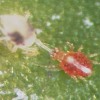 This predatory mite was recently discovered in an unsprayed greenhouse at the University of Florida, Gainesville, living on Phalaenopsis and Dendrobium orchids, and assumed to be feeding on orchid pests such as spider mites, tenuipalpid mites, and mealybugs that were present on the orchids. Because there was no published information on this species as a natural enemy of orchid pests, colonies were initiated here to study its biology, maintained on two-spotted spider mite prey. Hemicheyletia wellsina does not appear likely to be an effective natural enemy in agricultural crops as an introduced predator, but could be beneficial in natural biological control in natural ecosystems, where pest densities are lower. This 5-page fact sheet was written by Haleigh A. Ray and Marjorie A. Hoy, and published by the UF Department of Entomology and Nematology, December 2014. (Photo: Haleigh Ray, UF/IFAS)
This predatory mite was recently discovered in an unsprayed greenhouse at the University of Florida, Gainesville, living on Phalaenopsis and Dendrobium orchids, and assumed to be feeding on orchid pests such as spider mites, tenuipalpid mites, and mealybugs that were present on the orchids. Because there was no published information on this species as a natural enemy of orchid pests, colonies were initiated here to study its biology, maintained on two-spotted spider mite prey. Hemicheyletia wellsina does not appear likely to be an effective natural enemy in agricultural crops as an introduced predator, but could be beneficial in natural biological control in natural ecosystems, where pest densities are lower. This 5-page fact sheet was written by Haleigh A. Ray and Marjorie A. Hoy, and published by the UF Department of Entomology and Nematology, December 2014. (Photo: Haleigh Ray, UF/IFAS)
http://edis.ifas.ufl.edu/in1066
Tag: M. A. Hoy
Eriophyid mite vector of Rose Rosette Disease (RRD) Phyllocoptes fructiphilus Keifer (Arachnida: Acari: Eriophyidae)
 Phyllocoptes fructiphilus Keifer, a tiny eriophyid mite, is the vector of a devastating viral disease of roses called Rose Rosette Disease (RRD). This mite can be spread by the wind and by contaminated clothing and equipment. It also is possible that it can disperse through phoresy (attaching itself to insects). As a result, the distribution of the mite and RRD is expanding. This 5-page fact sheet was written by Marjorie Hoy, and published by the UF Department of Entomology and Nematology, May 2013.
Phyllocoptes fructiphilus Keifer, a tiny eriophyid mite, is the vector of a devastating viral disease of roses called Rose Rosette Disease (RRD). This mite can be spread by the wind and by contaminated clothing and equipment. It also is possible that it can disperse through phoresy (attaching itself to insects). As a result, the distribution of the mite and RRD is expanding. This 5-page fact sheet was written by Marjorie Hoy, and published by the UF Department of Entomology and Nematology, May 2013.
http://edis.ifas.ufl.edu/in999
Management of Orchid Pests with Silwet® L-77 and Horticultural Oils (PP287)
 IFAS researchers evaluated the ability of the surfactant Silwet® L-77 to improve the efficacy of horticultural oils in controlling boisduval scale and mite infestations in orchids. This 3-page fact sheet reports the results and provides homeowners with directions for its use. Written by R. A. Cating, M. A. Hoy, and A. J. Palmateer, and published by the UF Department of Plant Pathology, November 2011.
IFAS researchers evaluated the ability of the surfactant Silwet® L-77 to improve the efficacy of horticultural oils in controlling boisduval scale and mite infestations in orchids. This 3-page fact sheet reports the results and provides homeowners with directions for its use. Written by R. A. Cating, M. A. Hoy, and A. J. Palmateer, and published by the UF Department of Plant Pathology, November 2011.
http://edis.ifas.ufl.edu/pp287